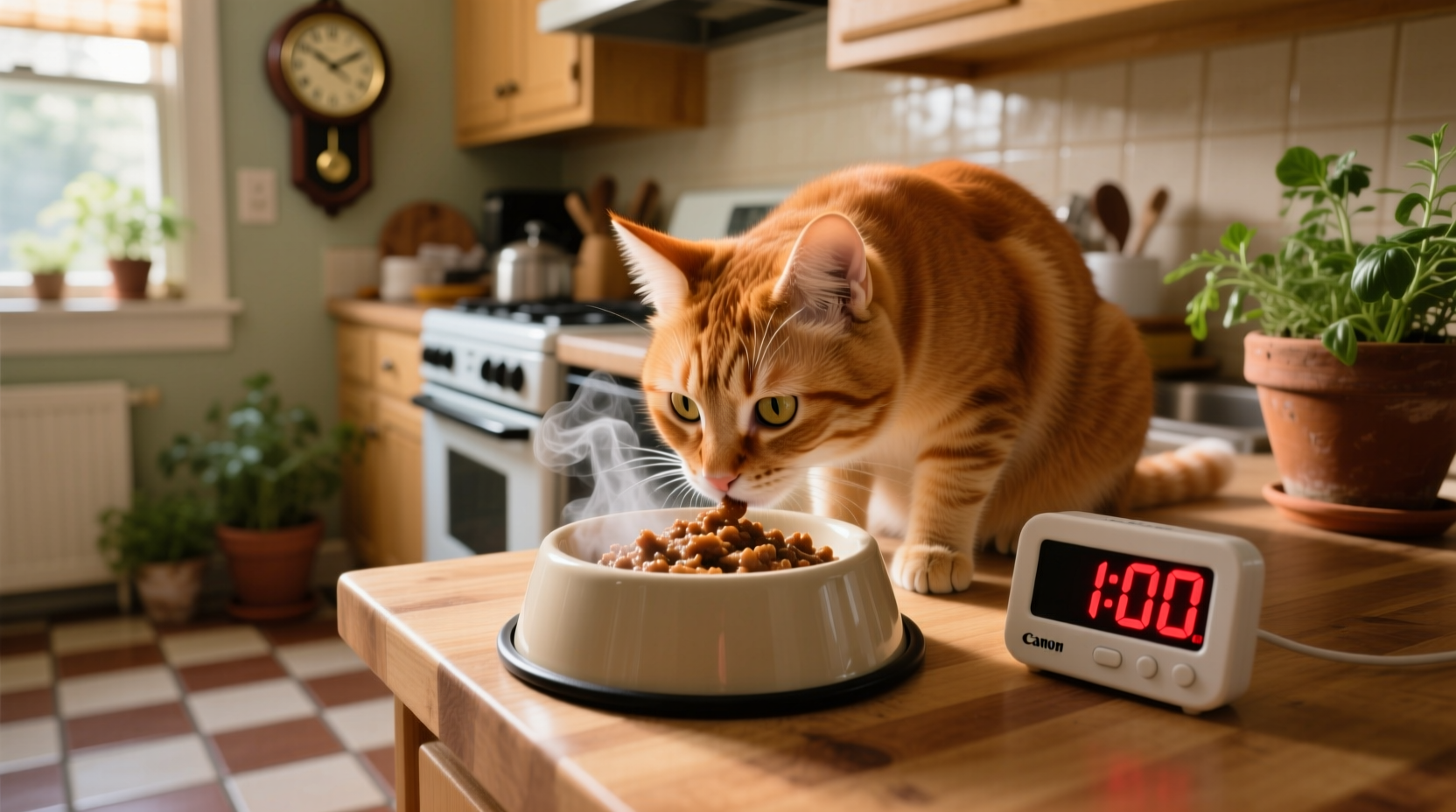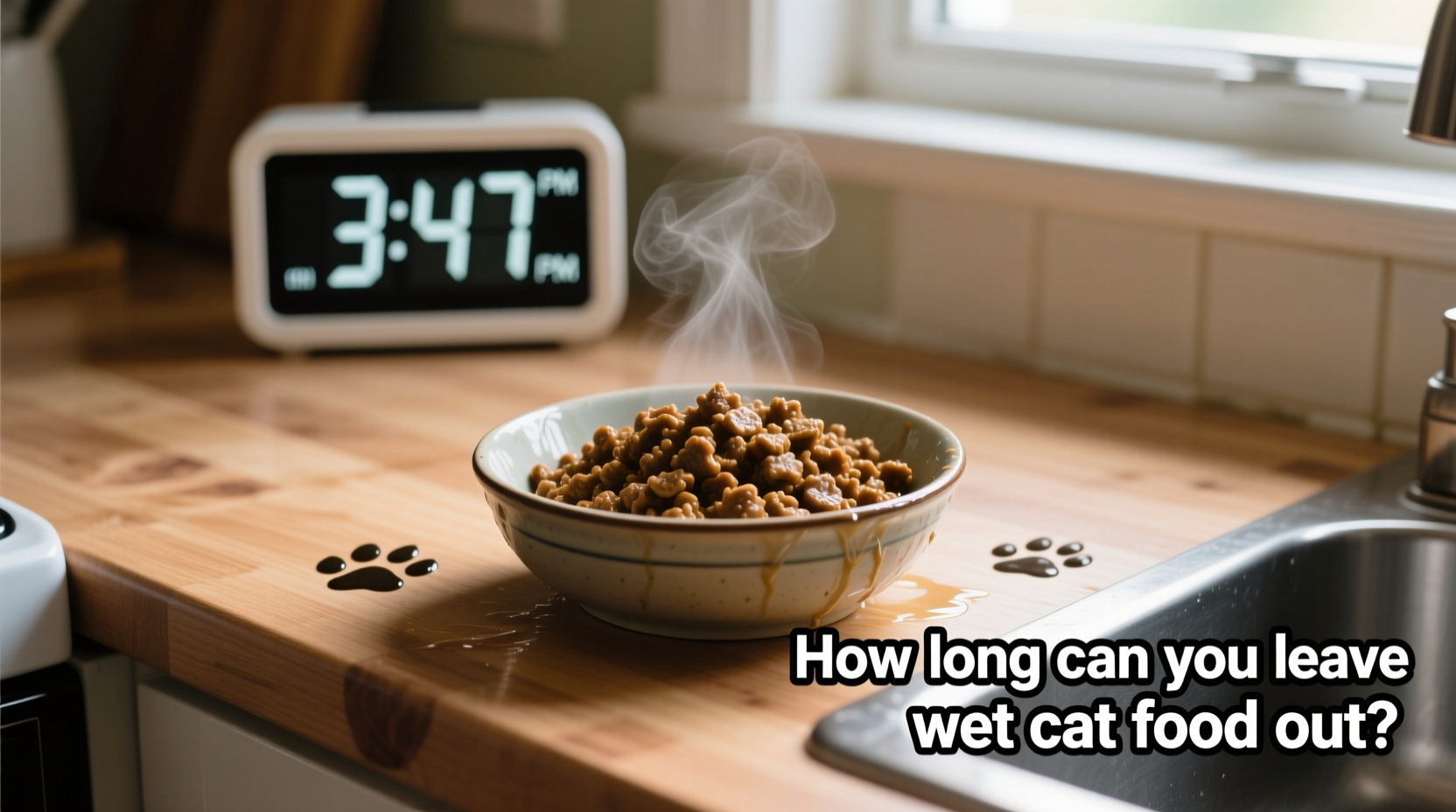As a food safety specialist with culinary training, I've seen how quickly perishable items can become hazardous when left out too long. Proper handling of wet cat food isn't just about freshness—it's a critical health consideration for your feline family member. Let's explore exactly how temperature affects wet cat food safety and what you need to do to keep your pet healthy.
Why Timing Matters: The Science Behind Wet Cat Food Safety
Wet cat food creates the perfect environment for bacterial growth because of its high moisture content and protein composition. When left at room temperature, bacteria like Salmonella and E. coli can multiply rapidly, doubling in number every 20 minutes under ideal conditions.
The U.S. Food and Drug Administration (FDA) identifies the "danger zone" for food safety as temperatures between 40°F and 140°F (4°C to 60°C). Within this range, bacteria thrive and multiply quickly. Wet cat food falls squarely into this category, making proper handling essential.
| Temperature Range | Bacterial Growth Rate | Safe Time Limit |
|---|---|---|
| Below 40°F (4°C) | Negligible growth | 3-5 days refrigerated |
| 40-70°F (4-21°C) | Slow growth | 2-4 hours |
| 70-90°F (21-32°C) | Rapid growth | 1-2 hours |
| Above 90°F (32°C) | Very rapid growth | 30-60 minutes |
The Bacterial Timeline: How Quickly Wet Food Spoils
Understanding the progression of bacterial growth helps explain why timing is so critical. Here's what happens when wet cat food sits out:
- 0-30 minutes: Bacteria begin to activate but remain at safe levels
- 30-60 minutes: Bacterial colonies start multiplying exponentially
- 1-2 hours: Bacteria reach levels that could cause gastrointestinal issues in cats
- 2-4 hours: Significant risk of foodborne illness with potential for severe symptoms
- 4+ hours: High probability of dangerous bacterial contamination
According to the Cornell University College of Veterinary Medicine, "Cats have more sensitive digestive systems than humans, making them particularly vulnerable to foodborne pathogens that might only cause mild discomfort in people." This explains why the safe window for wet cat food is shorter than for many human foods.

Practical Guidelines for Different Situations
Your specific environment dramatically affects how long wet cat food remains safe. Here's how to adjust your approach based on conditions:
Standard Room Temperature (70-75°F / 21-24°C)
Follow the standard 1-2 hour rule. Set a timer when you serve wet food to ensure you don't forget to remove uneaten portions. This practice prevents your cat from developing the habit of grazing throughout the day, which can lead to food spoilage issues.
Warm or Humid Conditions (Above 75°F / 24°C)
Reduce the safe window to 60-90 minutes. In particularly humid environments, moisture in the air accelerates bacterial growth. The American Society for the Prevention of Cruelty to Animals (ASPCA) recommends being especially vigilant during summer months when indoor temperatures rise.
Hot Weather (Above 90°F / 32°C)
Limited to 30-60 minutes maximum. During heat waves or in homes without air conditioning, consider serving smaller portions more frequently rather than leaving food out for extended periods.
Cooler Environments (Below 70°F / 21°C)
You might extend to 2-4 hours, but never exceed 4 hours total. While cooler temperatures slow bacterial growth, they don't stop it completely. The Pet Food Manufacturers' Association cautions that "even in cooler conditions, wet food begins deteriorating within hours."
Signs Your Wet Cat Food Has Gone Bad
Sometimes timing alone isn't enough—you need to recognize visual and sensory indicators of spoilage:
- Smell test: Fresh wet cat food has a mild meaty aroma. Spoiled food develops sour, rancid, or distinctly unpleasant odors. Trust your nose—if it smells off to you, it's definitely unsafe for your cat.
- Texture changes: Look for slimy film on the surface, unusual separation of ingredients, or excessive liquid pooling around the food.
- Visual cues: Discoloration (especially graying meat), mold growth (fuzzy spots in various colors), or bubbling/fermentation signs.
When in doubt, throw it out. The Association of American Feed Control Officials (AAFCO) emphasizes that "cats cannot vomit as efficiently as humans, making them more susceptible to foodborne illness complications."
Best Practices for Serving Wet Cat Food
Follow these professional food handling techniques to keep your cat safe:
- Portion control: Serve only what your cat will eat in one sitting (typically 3-5 ounces for an average adult cat)
- Temperature management: Serve food at room temperature—never straight from the refrigerator as the cold can reduce aroma appeal
- Container hygiene: Wash food bowls with hot, soapy water after each use—bacteria can linger in microscopic scratches
- Leftover protocol: Discard uneaten food after the safe time window—never refrigerate and reuse partially eaten portions
- Storage: Keep unopened cans in a cool, dry place; refrigerate opened portions in airtight containers for up to 3 days
Special Considerations for Vulnerable Cats
Certain cats require extra precautions due to increased vulnerability:
- Kittens: Their developing immune systems make them more susceptible—strictly adhere to 1-hour rule
- Senior cats: Weakened immunity requires extra vigilance—consider warming food slightly to enhance aroma for picky eaters
- Cats with health conditions: Those with kidney disease, diabetes, or compromised immune systems need the strictest food safety protocols
The American Association of Feline Practitioners notes that "older cats and kittens experience more severe symptoms from foodborne illnesses and recover more slowly than healthy adult cats."
Common Mistakes to Avoid
Even well-meaning cat owners make these critical errors:
- Leaving food out overnight: "Just in case" feeding creates significant health risks
- Reusing partially eaten food: Bacteria from your cat's mouth contaminates the food
- Ignoring expiration dates: Both unopened and opened food have limited shelf lives
- Using improper storage containers: Plastic containers can harbor bacteria in scratches—glass or stainless steel is preferable
Creating a Safe Feeding Routine
Establishing consistent habits protects your cat's health:
- Remove uneaten wet food after 1-2 hours
- Wash bowl thoroughly with hot, soapy water
- Store leftovers in airtight container in refrigerator
- Label containers with date of opening
- Discard refrigerated leftovers after 3 days
- Bring refrigerated food to room temperature before serving
By following these evidence-based guidelines, you'll significantly reduce the risk of foodborne illness while ensuring your cat enjoys fresh, appealing meals. Remember that proper food handling isn't just about preventing immediate illness—it supports your cat's long-term digestive health and overall wellbeing.
Frequently Asked Questions
Can I refrigerate wet cat food after my cat has eaten from it?
No, you should never refrigerate and reuse partially eaten wet cat food. Bacteria from your cat's mouth transfers to the food during eating, creating a contamination risk. Always discard uneaten portions after 1-2 hours and serve fresh food at the next mealtime.
How long does opened wet cat food last in the refrigerator?
Properly stored in an airtight container, opened wet cat food remains safe for 3-5 days in the refrigerator at 40°F (4°C) or below. Always label containers with the opening date and discard after 5 days maximum. Glass or stainless steel containers are preferable to plastic, which can harbor bacteria in microscopic scratches.
What happens if my cat eats spoiled wet food?
Symptoms of foodborne illness in cats include vomiting, diarrhea, lethargy, loss of appetite, and dehydration. Severe cases may require veterinary intervention. Cats cannot vomit as efficiently as humans, making them more vulnerable to complications. If your cat shows symptoms after eating potentially spoiled food, contact your veterinarian immediately.
Does warming wet cat food affect how long it can be left out?
Yes, warming wet cat food actually reduces the safe time window. Food heated to serving temperature (around 98-102°F / 37-39°C) enters the bacterial "danger zone" more quickly. If you warm the food, serve it immediately and reduce the safe exposure time to 30-60 minutes rather than the standard 1-2 hours for room-temperature food.
Are there any wet cat foods that can be left out longer?
No, all meat-based wet cat foods follow the same food safety guidelines regardless of brand or formulation. The high moisture content and protein composition create ideal conditions for bacterial growth. Even foods with preservatives shouldn't be left out beyond the 1-2 hour guideline. The only exception would be specially formulated dry foods designed for free-feeding.











 浙公网安备
33010002000092号
浙公网安备
33010002000092号 浙B2-20120091-4
浙B2-20120091-4